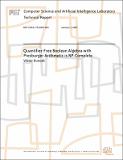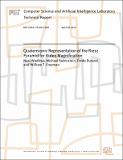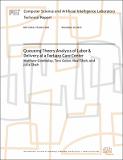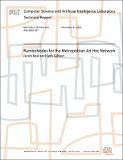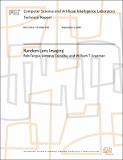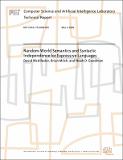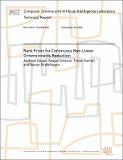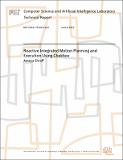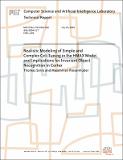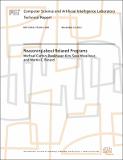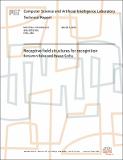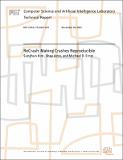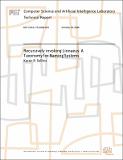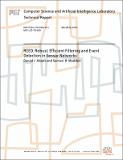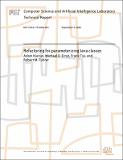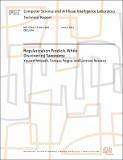Browsing CSAIL Digital Archive by Title
Now showing items 579-598 of 806
-
Quantifier-Free Boolean Algebra with Presburger Arithmetic is NP-Complete
(2007-01-01)Boolean Algebra with Presburger Arithmetic (BAPA) combines1) Boolean algebras of sets of uninterpreted elements (BA)and 2) Presburger arithmetic operations (PA). BAPA canexpress the relationship between integer variables ... -
Quantitative Information Flow as Network Flow Capacity
(2007-12-10)We present a new technique for determining how much information abouta program's secret inputs is revealed by its public outputs. Incontrast to previous techniques based on reachability from secretinputs (tainting), it ... -
Quantitative Information-Flow Tracking for C and Related Languages
(2006-11-17)We present a new approach for tracking programs' use of data througharbitrary calculations, to determine how much information about secretinputs is revealed by public outputs. Using a fine-grained dynamicbit-tracking ... -
Quaternionic Representation of the Riesz Pyramid for Video Magnification
(2014-04-26)Recently, we presented a new image pyramid, called the Riesz pyramid, that uses the Riesz transform to manipulate the phase in non-oriented sub-bands of an image sequence to produce real-time motion-magnified videos. In ... -
Queueing Theory Analysis of Labor & Delivery at a Tertiary Care Center
(MIT CSAIL, 2014-12-16)Labor and Delivery is a complex clinical service requiring the support of highly trained healthcare professionals from Obstetrics, Anesthesiology, and Neonatology and the access to a finite set of valuable resources. In ... -
RamboNodes for the Metropolitan Ad Hoc Network
(2003-12-17)We present an algorithm to store data robustly in a large, geographically distributed network by means of localized regions of data storage that move in response to changing conditions. For example, data might migrate away ... -
Random Lens Imaging
(2006-09-02)We call a random lens one for which the function relating the input light ray to the output sensor location is pseudo-random. Imaging systems with random lensescan expand the space of possible camera designs, allowing new ... -
Random-World Semantics and Syntactic Independence for Expressive Languages
(2008-05-03)We consider three desiderata for a language combining logic and probability: logical expressivity, random-world semantics, and the existence of a useful syntactic condition for probabilistic independence. Achieving these ... -
Rank Priors for Continuous Non-Linear Dimensionality Reduction
(2008-09-26)Non-linear dimensionality reduction methods are powerful techniques to deal with high-dimensional datasets. However, they often are susceptible to local minima and perform poorly when initialized far from the global optimum, ... -
Rational Robustness for Mechanism Design
(2009-11-10)The currently prevailing equilibrium-based approach to mechanism design suffers from a plurality of fundamental problems, and new conceptual frameworks are needed to solve or sufficiently alleviate them. In this paper, we ... -
Reactive Integrated Motion Planning and Execution Using Chekhov
(2013-06-06)We envision a world in which robots and humans can collaborate to perform complex tasks in real-world environments. Current motion planners successfully generate trajectories for a robot with multiple degrees of freedom, ... -
Realistic Modeling of Simple and Complex Cell Tuning in the HMAXModel, and Implications for Invariant Object Recognition in Cortex
(2004-07-27)Riesenhuber \& Poggio recently proposed a model of object recognitionin cortex which, beyond integrating general beliefs about the visualsystem in a quantitative framework, made testable predictions aboutvisual processing. ... -
Reasoning about Relaxed Programs
(2011-11-15)A number of approximate program transformations have recently emerged that enable transformed programs to trade accuracy of their results for increased performance by dynamically and nondeterministically modifying variables ... -
Receptive field structures for recognition
(2005-03-01)Localized operators, like Gabor wavelets and difference-of-Gaussian filters, are considered to be useful tools for image representation. This is due to their ability to form a ‘sparse code’ that can serve as a basis set ... -
ReCrash: Making Crashes Reproducible
(2007-11-20)It is difficult to fix a problem without being able to reproduce it.However, reproducing a problem is often difficult and time-consuming.This paper proposes a novel algorithm, ReCrash, that generatesmultiple unit tests ... -
Recursively invoking Linnaeus: A Taxonomy for Naming Systems
(2002-03-01)Naming is a central element of a distributed or network system design. Appropriate design choices are central. This paper explores a taxonomy of naming systems, and engineering tradeoffs as an aid to the namespace designer. ... -
REED: Robust, Efficient Filtering and Event Detection in Sensor Networks
(2004-03-22)This paper presents an algorithm for handling many types of filters insensor networks that cannot be expressed using a simple predicate.Specifically, the action of the filter may be predicated on sensor produceddata where ... -
Refactoring for parameterizing Java classes
(2006-09-05)Type safety and expressiveness of many existing Java libraries and theirclient applications would improve, if the libraries were upgraded to definegeneric classes. Efficient and accurate tools exist to assist clientapplications ... -
Refactoring Sequential Java Code for Concurrency via Concurrent Libraries
(2008-09-30)Parallelizing existing sequential programs to run efficiently on multicores is hard. The Java 5 packagejava.util.concurrent (j.u.c.) supports writing concurrent programs: much of the complexity of writing threads-safe and ... -
Regularization Predicts While Discovering Taxonomy
(2011-06-03)In this work we discuss a regularization framework to solve multi-category when the classes are described by an underlying class taxonomy. In particular we discuss how to learn the class taxonomy while learning a multi-category ...

